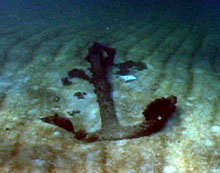NOWRAMP
2002
The
Footprints of Ships: Notes About Anchors
Written By Hans Van Tilburg, Ph.D, "Dr. Shipwreck"
 Anchors
are somewhat like the footprints of ships and shipwrecks.
Not only can you learn about their approximate age and use
by observing their design (Admiralty style, folding stock,
danforth, stockless, yachtsman, "lunch hook" etc.),
but their position on the seafloor can reveal important
clues to the maritime past.
Anchors
are somewhat like the footprints of ships and shipwrecks.
Not only can you learn about their approximate age and use
by observing their design (Admiralty style, folding stock,
danforth, stockless, yachtsman, "lunch hook" etc.),
but their position on the seafloor can reveal important
clues to the maritime past.
For
instance, if you find an anchor sitting on top of a shallow
reef sticking out of the water, and there's no anchor chain
attached…this is probably a trophy, something historic
that someone found and brought back to put on display. No
ship would seriously consider dropping its anchor in three
feet of water on top of a reef! Ask the folks at Tern Island,
they have a couple historic examples of this very thing.
 If
you find an anchor at the edge of a reef in shallow water…it's
probably there to hold a buoy in place, marking a passage
through the coral to the nearby beach landing. Laysan has
old anchors off the landing which used to do this for the
guano operations on the island. But if you find an anchor
on a rocky bottom, its flukes not set deep in sand, and
the anchor chain runs straight as an arrow in the direction
of the shore…follow it! Some stricken vessel attempted
(unsuccessfully) to save itself before going aground. You're
on the trail of a shipwreck.
If
you find an anchor at the edge of a reef in shallow water…it's
probably there to hold a buoy in place, marking a passage
through the coral to the nearby beach landing. Laysan has
old anchors off the landing which used to do this for the
guano operations on the island. But if you find an anchor
on a rocky bottom, its flukes not set deep in sand, and
the anchor chain runs straight as an arrow in the direction
of the shore…follow it! Some stricken vessel attempted
(unsuccessfully) to save itself before going aground. You're
on the trail of a shipwreck.